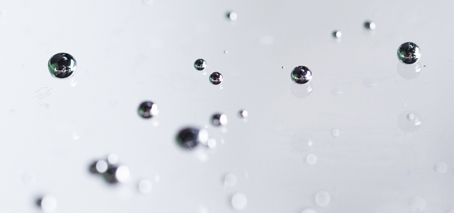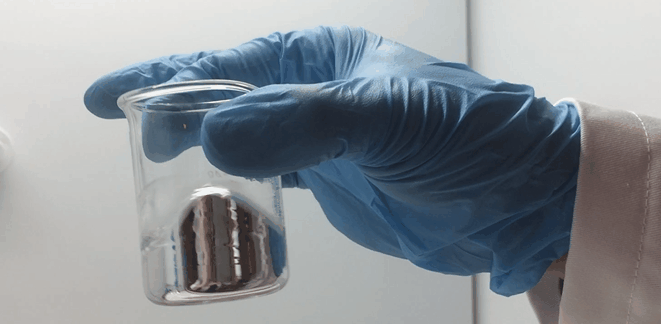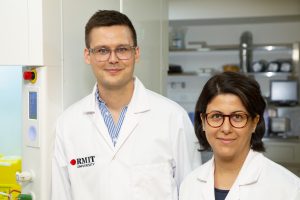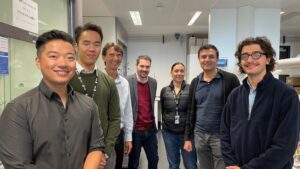The Liquid-metals spin-off company Liquid Metal Plus (LM+) initiated in 2020 with FLEET investigators Kourosh Kalantar-Zadeh (UNSW) and Dr Torben Daeneke (RMIT), together with Dorna Esrafilzadeh (UNSW), was launched in April 2021.
- Pushing print on flexible touchscreens
- Climate rewind: turning CO2 back into coal
The company has two areas of focus, with the unifying theme being application of liquid-metal technologies developed by Daeneke and Kalantar-Zadeh, and described when initially published as a ‘once in a decade’ advance.
The first focus is on two dimensional (2D) ‘printed’ semiconductors, while the second is use of the technology in capturing CO2 and turning it back into carbon.
Just push ‘print’ on flexible electronics
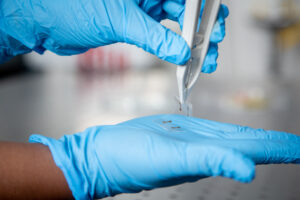
Ultra-thin, ultra-flexible materials could be printed and rolled out like newspaper, for the touchscreens of the future.
Building on previous success with liquid metals, the team developed an ultra-thin and ultra-flexible electronic material, able to be printed and rolled out like newspaper, for the touchscreens of the future.
The touch-responsive technology is 100 times thinner than existing touchscreen materials and so pliable it can be rolled up like a tube.
“This ‘transformed’ material is supremely thin and flexible,” says Liquid Metal Plus (LM+) cofounder Prof Kourosh Kalantar-Zadeh. “It can be easily bent or twisted, and can be manufactured far more cheaply and efficiently than current touchscreen technology.” Making the material two-dimensional also makes it more transparent, so it lets through more light. “This means a mobile phone with a touchscreen made of our material would use less power, extending the battery life by roughly 10%,” says Prof Kalantar-zadeh.
Climate rewind: liquid-metal carbon capture
In 2019 the team demonstrated use of liquid metals to turn carbon dioxide back into solid coal, in a world-first breakthrough that could transform our approach to carbon capture and storage.
The efficient conversion of CO2 from a gas into solid particles of carbon offers an alternative pathway for safely and permanently removing the greenhouse gas from our atmosphere.
“While we can’t literally turn back time, turning carbon dioxide back into coal and burying it back in the ground is a bit like rewinding the emissions clock,” says researcher and LM+ patent holder Dr Torben Daeneke.
Commercialising research
This new spin off entity has been set up specifically to commercialising liquid-metal research developed by Kourosh and Torben at FLEET (and collaborators including Dorna at UNSW and their teams) into commercially-viable technologies that will deliver benefits to shareholders (and the Australian community!). The company is also considering future technological advancement that emerge from Kourosh’s and Torben’s laboratories.
Liquid Metal Plus was initiated at UNSW and received substantial funding for its existence from UniSeed. LM+ has two patents – one on the deposition of atomically thin ITO glasses (high mobility optically transparent 2D materials) and one on CO2 conversion into graphene oxides. Both of them under the spin off “company liquid metal plus”.
FLEET AI Dr Torben Daeneke and FLEET CI Prof Kourosh Kalantar-Zadeh (together with one other partner) hope that the current and future innovations under the banner of LM+ leave great impacts on people’s lives, and lead to sustainable commercial products.
More information
- Contact Prof Kourosh Kalantar-zadeh (UNSW) k.kalantar-zadeh@unsw.edu.au
- Contact Dr Torben Daeneke (RMIT) torben.daeneke@rmit.edu.au
- Read Liquid metal provides ‘once-in-a-decade’ advance in 2D material deposition
- Read Climate rewind: scientists turn carbon dioxide back into coal
- Read Nano-thin flexible touchscreens could be printed like newspaper

